Advertisement
Marine electronics production has been slow the past few years, but the floodgates are now open, leaving consumers awash in innovation.

Garmin GPSMAP 8624.
When it comes to the electronics on our boats, we should all know our AC from our DC — but what about PC? No, not political correctness — we're talking post-Covid. Yes, we're well aware the virus hasn't disappeared from daily life, but its role in the marine manufacturing world has diminished significantly. The pandemic led to supply-chain backlogs, leaving manufacturers struggling to meet demand for existing products, much less develop next-generation merchandise. This explains why the introduction of new tech and gear has been sparse these last few years.
We noticed a shift mid-2022 when the well-known brands starting teasing our BoatUS Magazine editors with bona fide innovative stuff. We got a sneak peek from the industry last fall, so as the 2023 season creeps closer, allow us to showcase what's cool, hot, and new in the world of "PC" marine electronics.
Blind Spot Eliminator
Docking a boat can be difficult when you can't see past the bow or across the transom, an issue now addressed with the Garmin Surround View Camera System. Stitching together the view from six different cameras, Surround View gives you 360-degree views at the helm, and creates a live "bird's-eye" view looking down on your boat. You can also set a "visual bumper" indicator on the screen so you know when a dock, pier, or another boat is about to violate a preset barrier limit. Distance markers also help ascertain exactly how close your boat is getting to any object and, if desired, you can pull up each camera's view individually. OEM, so look for pricing as an option on a new boat | Garmin.com
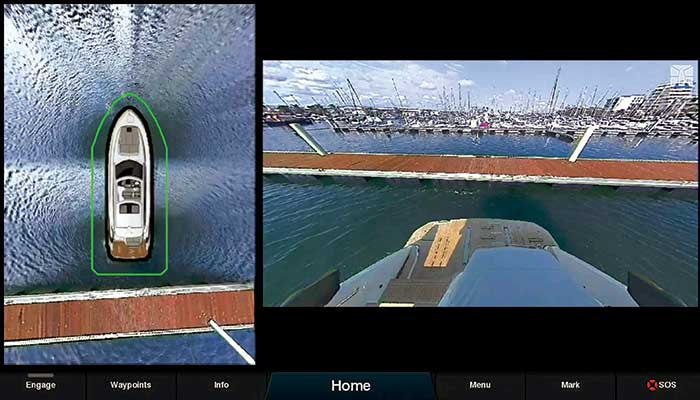
Garmin Surround View Camera System provides eyes in the back of your head.
Color & Clarity
Navionics digital cartography is known for its level of detail and ease of use. Garmin bought the mapmaker in 2017, but only now has fully integrated Navionics charts across its entire line of Garmin GPSMAP units (look for Garmin Navionics+ and Garmin Navionics Vision+). From the diminutive 743xsv to the movie-screen-like 8624 models, these now come with Navionics inland and coastal mapping built in. The color palettes and interface have been tweaked to provide improved detail and visibility. Also new are auto-routing capabilities, and color-shaded depth ranges with up to 1-foot contour detail. $1,099 to $12,299 | Garmin.com
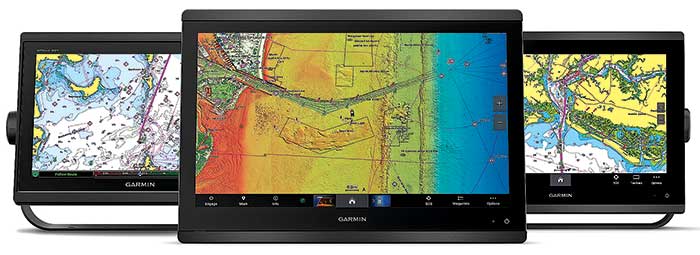
The entire Garmin GPSMAP line now comes with standard Navionics cartography.
See Through Salty Seas
Garmin's LiveScope virtual real-time imaging changed the way freshwater anglers fish and allowed them to spot fish beneath the surface with such detail that it became possible to judge the species and its size long before taking a first cast. The downside? Because of very limited range in saltwater environments, it didn't do much for coastal and oceanic anglers. LiveScope XR solves that problem. Using the GLS 10 black box, a LVS62 transducer, stabilizers to mitigate the effect of waves, and multiple color patterns, you can probe the brine out to 350 feet. Freshwater anglers also benefit with LiveScope XR, as a previous range of 200 feet can be extended out to 500 feet. Boats with bow-mounted electric trolling motors (which act as the transducer mount) will find the most utility from this system. Rigs with an existing GLS 10 can be upgraded to XR with a (free) software update and the LVS62 transducer. $2,999.99 | Garmin.com

Saltwater anglers can see through the brine out to 350 feet with LiveScope XR from Garmin.
Power To The People
What's the best thing about not having a generator? Not having to listen to the rumble and grumble of a generator. Still, we need our power. Navico Group's Fathom lithium-ion power management system aims to provide ample juice to run everything from air conditioning to galley appliances via a combination of power conversion and distribution, digital switching, and control/monitoring, with powerful lithium-ion batteries at the heart of the system. It's available in 12-, 24-, and 48-volt systems for boats ranging from 27- to 35-plus feet, and can be controlled with an app on your smart device. Preconfigured kits are scheduled to launch through 2023. OEM product (look for it as a new-boat option), or available as custom kits ranging from $1,000 to $17,000+ | Navico.com
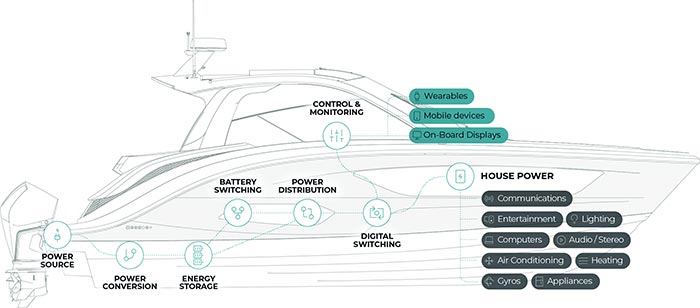
The new Fathom lithium-ion power management system does it all.
Old Boat, New Tricks
Joystick controls have made life easier for many boaters when it comes to virtual anchoring, close-quarters maneuvering, and docking. But most of the systems out there are intended for outboards, sterndrives, and pod drives, leaving lots of boaters with straight-shaft inboards to go without. Twin Disc has a new solution with Express Positioning, which is compatible with boats incorporating single or twin inboards plus hydraulic thrusters. ABT-TRAC TRAC-Link and Side Power S-Link thrusters at the bow or both bow and stern are integrated with the inboard's transmission(s) to hold your boat in place or make micro-adjustments to its position, even in high wind and/or high-current conditions, while a full-color display provides an interface showing position, system status, and operational parameters. Price varies by installation | TwinDisc.com
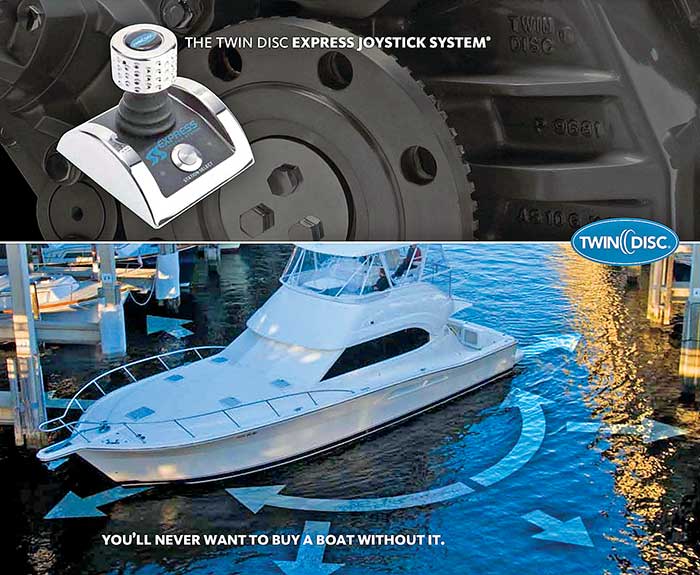
Twin Disc figured out how to add joystick control to straight-shaft inboards.
Stay In Touch
Having full connectivity once meant you needed multiple antennas, had to manually switch between carriers to maintain connectivity, and had no idea how much data you were chewing through until that eye-popping bill arrived in the mail. The KVH TracPhone LTE 1 aims to solve those problems, packing a high-gain dual LTE-A antenna array, modem, GPS, and Wi-Fi router into a 6.25-pound, 13.5- by 13.3-inch dome. KVH promises you can pull in cell coverage when over 20 miles from the nearest cell tower (with antenna mounted 20 feet above the waterline) and enjoy faster-than-4G data speeds with automatic switching between carriers and multi-device connectivity.
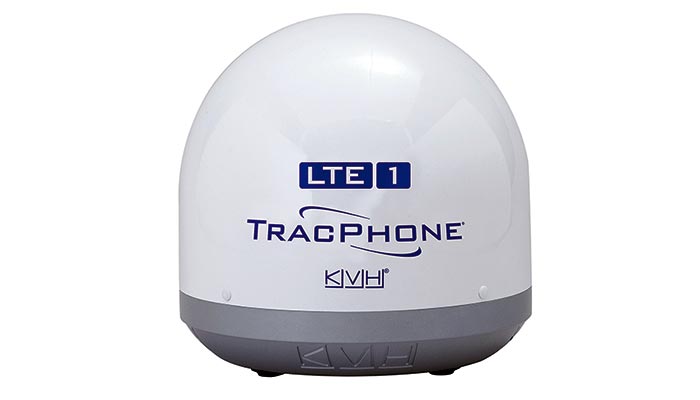
TracPhone LTE-1 packs satellite, cellular, Wi-Fi, modem, and GPS into one dome.
The LTE Manager App allows you to see your data usage at any time. You can also set usage alerts via text or email, so you get a heads-up long before those bills arrive. $1,595 | KVH.com
For Some Perspective On Pricing
What's the most significant development in the world of marine electronics since the turn of the century? You can make arguments for total system integration; simpler, intuitive user interfaces; or the advent of touchscreens. But if you measure "most significant" in terms of impact on the greatest number of boaters, the development to focus on is probably the massive increase in bang-for-your-buck. Flash back to the dawn of the 21st century: Today's relatively inexpensive midrange multifunction displays (MFDs) have the capabilities of full-blown nav suites that would have cost tens of thousands of dollars back in 2000.
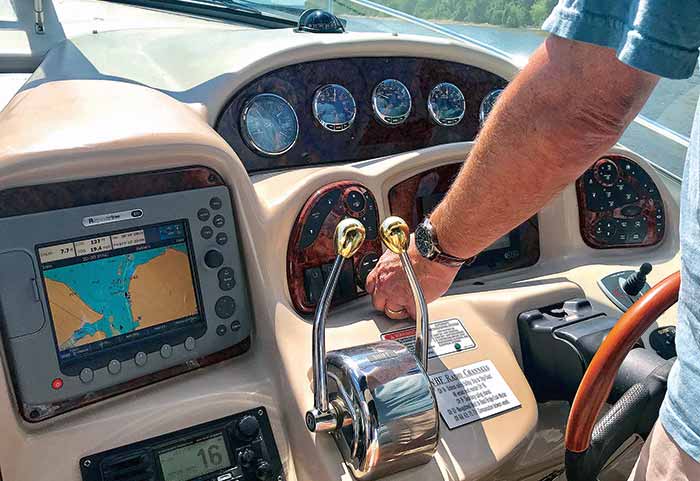
Then. (Photo: Rich Armstrong)
Remember back when everyone was freaking out over the Y2K bug that might crash all computers at the end of 1999? If you wanted complete navigational nirvana, you'd have spent $6,500 for a 10-inch color chartplotter with differential GPS (Northstar 961); $200 for a halfway decent chart chip (C-Map NT); $2,000 for a standard-issue 6.4-inch color fishfinder (Lowrance LCX-16CI); $3,000 to get a dinky entry-level standalone radar with a 6- to 8-inch LCD display (Furuno 1712); and $3,200 for an autopilot (Raymarine ST6001, core pack and drive unit). In total, you were looking at around $15,000 for a complete system — installation not included!
Today, you can get a Raymarine Element HV 12-inch full-color touchscreen LCD with twice the resolution of the vintage 2000 screens and all the listed accessories above for around $7,500. Your fishfinder now has 3D, side-scan, down-scan, and CHIRP (all distant dreams in 2000). You'll also have AIS display capability (yet to exist for the old package) and a long list of abilities that also weren't commonly seen at the turn of the century, such as overlaying your radar over your chartplotter, splitting multiple screens between chartplotter and fishfinder, bringing up engine data on your MFD, and so on. A complete package with the Garmin GPSMAP 1242xsv package, Lowrance HDS-12 LIVE, Simrad GO 12XSE, or Furuno TZTL12F all swim the same pricing and packages waters, and come in under the $10,000 mark.
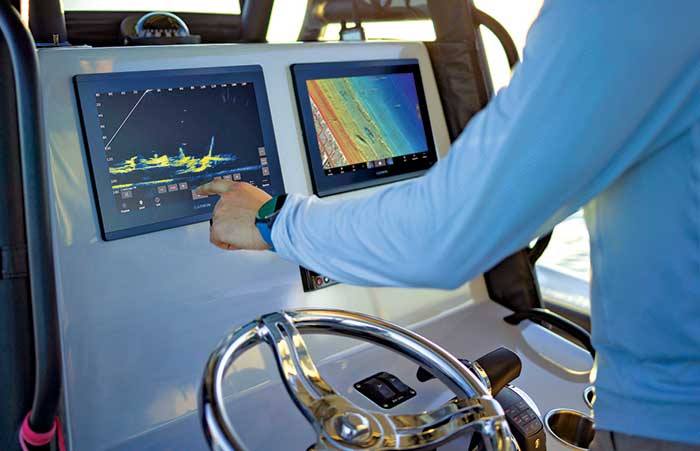
Now. (Photo: Rich Armstrong)
So let's use $15,000 versus $7,500 as our impressive comparative price drop by 50% for what today constitutes a mid-level marine electronics system. And that understates all the value-added features and functionality we get out of today's systems. So for the broadest swath of the boating public, the bottom line is that the single, most-impactful change in marine electronics since the turn of the century is an impressive decrease in cost.
